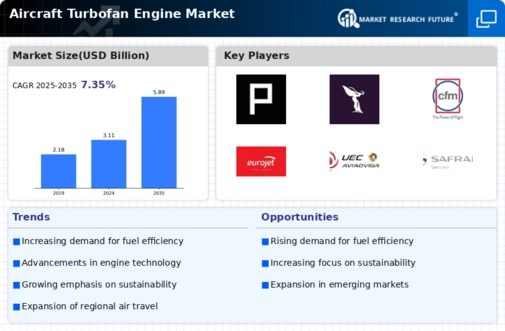Top Industry Leaders in the Aircraft Turbofan Engine Market

Key players :
Pratt & Whitney (U.S.)
Aviation (U.S.)
Rolls Royce (U.K.)
CFM International (U.S.)
Honeywell International (U.K.)
EuroJet (U.S.)
Aviadvigatel (Russia)
Safran Aircraft Engines (France)
International Aero Engines AG (U.S.)
MTU Aero Engines (Germany)
Engine Alliance (U.S.)
Strategies Adopted
The Aircraft Turbofan Engine market is a dynamic and highly competitive sector, driven by the constant demand for more fuel-efficient, powerful, and environmentally friendly propulsion systems in the aviation industry. Key players in this market are engaged in fierce competition, employing various strategies to gain a competitive edge. One of the primary strategies adopted by leading companies is continuous research and development to enhance the performance and efficiency of their turbofan engines. Investment in cutting-edge technologies, such as advanced materials and digital innovations, is a common theme among these market leaders.
Rolls-Royce Holdings plc stands out as a prominent player in the aircraft turbofan engine market, with a strong focus on technological innovation. The company has been investing significantly in the development of next-generation engines, incorporating features like composite materials and advanced aerodynamics to improve fuel efficiency. Rolls-Royce's commitment to sustainability is evident in its efforts to reduce carbon emissions and enhance overall engine performance. This approach has helped the company maintain a substantial market share, as airlines seek more environmentally friendly solutions.
General Electric (GE) Aviation is another key player in the competitive landscape, leveraging its extensive experience and expertise in aviation technology. GE has adopted a strategy that encompasses both commercial and military applications, diversifying its portfolio to mitigate risks associated with market fluctuations. The company's emphasis on digital solutions, data analytics, and predictive maintenance has enabled it to offer comprehensive engine management services, further enhancing its competitiveness in the market.
Pratt & Whitney, a subsidiary of Raytheon Technologies Corporation, is renowned for its innovative geared turbofan (GTF) technology. This cutting-edge design has garnered attention for its fuel efficiency and reduced environmental impact. Pratt & Whitney's strategic collaborations with aircraft manufacturers have strengthened its position in the market, as it becomes the preferred choice for various aircraft models. The company's commitment to sustainability aligns with the global aviation industry's push towards greener practices.
Emerging Companies
New and emerging companies are also making their mark in the aircraft turbofan engine market, contributing to the competitive landscape. One notable entrant is AeroFarms, which brings a fresh perspective by focusing on sustainable aviation fuel (SAF) production. The company's innovative approach to biofuel production using vertical farming techniques positions it as a potential disruptor in the market. As the aviation industry intensifies its efforts to reduce carbon emissions, companies like AeroFarms may play a pivotal role in shaping the future of aircraft propulsion.
In terms of industry news, collaborations and partnerships are frequent occurrences as companies strive to combine their strengths and create more comprehensive solutions. For example, recent collaborations between engine manufacturers and technology companies aim to integrate artificial intelligence and machine learning into engine management systems. These advancements not only improve performance but also enable predictive maintenance, reducing downtime and operational costs for airlines.
Current company investment trends reflect a significant focus on sustainability and environmental responsibility. With the aviation industry under increasing pressure to address its carbon footprint, companies are allocating substantial resources to develop eco-friendly propulsion systems. Investments in research and development, particularly in alternative fuels and advanced materials, demonstrate a commitment to meeting future environmental standards and regulations.
The overall competitive scenario in the aircraft turbofan engine market is characterized by a constant quest for innovation, technological advancements, and sustainable practices. Companies that can successfully navigate these challenges while meeting the evolving needs of the aviation industry are likely to thrive in this competitive landscape. The ongoing efforts to reduce carbon emissions and enhance fuel efficiency present both challenges and opportunities, shaping the future trajectory of the aircraft turbofan engine market. As the industry continues to evolve, collaboration and innovation will remain key drivers of success in this dynamic and competitive sector.
Recent News
January 2024: GE Aviation and CFM International (a joint venture with Safran Aircraft Engines) successfully ground tested the GE9X engine variant for the Boeing 777X freighter. This engine boasts the world's largest fan diameter and promises exceptional fuel efficiency and reduced emissions.
December 2023: Launched the RISE (Revolutionary Integrated Synergistic Engine) program, aiming to develop a revolutionary new turbofan engine with a 20% improvement in fuel efficiency compared to current models.
October 2023: Achieved operational readiness for the Passport engine on the Gulfstream G700 Gen 3 business jet, offering outstanding performance and low operating costs.
January 2024: Rolls-Royce secured a contract with Airbus to supply Trent XWB-97 engines for the new A350F freighter variant. This variant offers increased payload capacity and operational flexibility.
November 2023: Successfully completed the first flight test of the UltraFan engine demonstrator, showcasing its geared turbofan technology for improved fuel efficiency and noise reduction.
September 2023: Announced a partnership with Airbus to develop hybrid-electric propulsion systems for future aircraft, aiming to significantly reduce carbon emissions.
January 2024: Pratt & Whitney's GTF engine family surpassed 100 million flight hours, further solidifying its position as a leading fuel-efficient engine option.
December 2023: Unveiled the PW1217G-JM engine for the Airbus A321neo XLR aircraft, providing longer range and improved payload capabilities.
October 2023: Received FAA certification for the PW814G engine on the Dassault Falcon 6X business jet, highlighting its performance and reliability.
January 2024: Safran and GE Aviation achieved the first ground test of their CFM RISE demonstrator engine, marking a significant step towards the development of the next generation of turbofan engines.
December 2023: Signed a contract with Pratt & Whitney to collaborate on the development of hybrid-electric propulsion systems for regional jets.
September 2023: Successfully completed the first engine run of the GE9X variant for the Boeing 777X freighter, paving the way for its entry into service.


